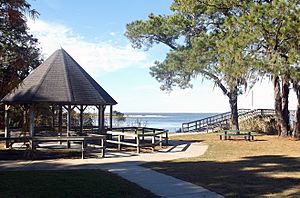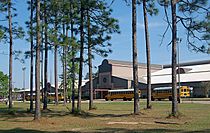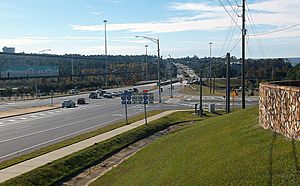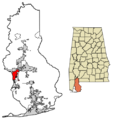Daphne, Alabama facts for kids
Quick facts for kids
Daphne, Alabama
|
||
|---|---|---|
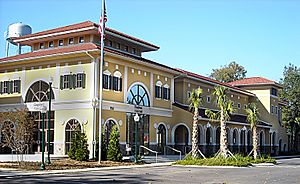
Daphne City Hall
|
||
|
||
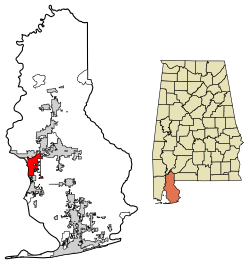
Location of Daphne in Baldwin County, Alabama.
|
||
| Country | United States | |
| State | Alabama | |
| County | Baldwin | |
| Founded | 1763 | |
| Area | ||
| • Total | 19.11 sq mi (49.49 km2) | |
| • Land | 18.99 sq mi (49.19 km2) | |
| • Water | 0.12 sq mi (0.31 km2) | |
| Elevation | 157 ft (48 m) | |
| Population
(2020)
|
||
| • Total | 27,462 | |
| • Density | 1,445.98/sq mi (558.30/km2) | |
| Time zone | UTC-6 (Central (CST)) | |
| • Summer (DST) | UTC-5 (CDT) | |
| ZIP code |
36526
|
|
| Area code(s) | 251 | |
| FIPS code | 01-19648 | |
| GNIS feature ID | 0157933 | |
| Website | http://www.daphneal.com/ | |
Daphne (pronounced DAF-nee) is a city in Baldwin County, Alabama, United States. It sits on the eastern shore of Mobile Bay. You can find it along I-10, about 11 miles east of Mobile.
In 2020, Daphne had a population of 27,462 people. This makes it the largest city in Baldwin County. Daphne is also known as "The Jubilee City." This is because of the special natural event called a Mobile Bay jubilee. During a jubilee, crabs, shrimp, and fish suddenly come to the shore. This happens when oxygen levels in the water drop, forcing sea life to the surface. Mobile Bay is one of only two places in the world where this amazing event occurs! The other is in Tokyo Bay.
Contents
- Discovering Daphne's Past: A Journey Through Time
- Daphne's Location and Natural Wonders
- =Daphne's Climate: Warm and Sunny
- People of Daphne: A Growing Community
- Daphne's Economy: A Growing Community
- Fun and Recreation in Daphne: Parks and More
- Learning in Daphne: Schools and Colleges
- Daphne's Infrastructure: How the City Works
- Healthcare in Daphne: Staying Healthy
- Famous People from Daphne
- Images for kids
- See also
Discovering Daphne's Past: A Journey Through Time
The area where Daphne is located has a very long history. People have lived here since at least 9,000 BCE. Over time, many different groups have called this place home.
Early Native American Life in Daphne
Long ago, hunter-gatherer tribes lived in the Daphne area. These included the Tensaw, Choctaw, Creek, and Seminole tribes. This land was a special meeting place for different tribes. They would gather to discuss important matters.
These early people worked together to find food. They also made tools and pottery. Around 1500, about 5,000 Native Americans lived near the coast. They were among the first to meet Spanish explorer Hernando de Soto in 1540.
European Explorers and Settlers Arrive
Daphne's land changed hands many times between European powers.
- In 1557, the Spanish were the first Europeans to arrive.
- By 1710, French explorers claimed the area, including Daphne.
- In 1763, the British took control from the French after a war. The community of Daphne was founded that same year. It was simply called "The Village."
- British rule ended in 1783 when the land went back to Spain.
- Finally, in 1814, U.S. General Andrew Jackson secured the area for the United States.
Daphne's Modern History and Growth
Daphne became the county seat of Baldwin County, Alabama in 1868. This happened after the previous county seat, Blakeley, was abandoned. At that time, Daphne was known as The Village of Bell Rose. The name Daphne became official on April 9, 1874, when its Post Office opened.
In the late 1800s, many immigrant groups moved to Baldwin County. In 1888, Italian immigrants came to Daphne. They wanted a peaceful place away from big cities. In 1895, land was bought for a Catholic church. This church, called the Church of the Assumption, was built by these early Italian settlers.
Daphne was the county seat until 1900. Then, the county seat was moved to Bay Minette. The county records were moved there in 1901.
On July 8, 1927, Daphne officially became an incorporated town. This meant it had its own local government. The first mayor was James M. Voltz.
Daphne has experienced some strong storms. Hurricane Danny hit in 1997. Hurricane Ivan caused widespread damage in 2004. Hurricane Katrina also affected Daphne in 2005.
In 2010, Daphne became the first city in the Mobile area to ban texting while driving.
Daphne's Location and Natural Wonders
Daphne is located at 30°37'52.640" North, 87°53'11.184" West. It's part of what locals call the "Eastern Shore." The other two cities are Spanish Fort to the north and Fairhope to the south.
The land in Daphne gently slopes from the bay up to low rolling hills. Most of the city is less than 150 feet above sea level. The soil near the bay is sandy.
The city covers about 14.1 square miles. About 13.5 square miles are land, and 0.6 square miles are water.
What is a Mobile Bay Jubilee?
Daphne is famous for the "Jubilee." This is a rare event where crabs, shrimp, and fish suddenly appear along the shoreline. Scientists think it happens when oxygen levels in the water drop. This forces the sea creatures to the surface, making them easy to catch!
=Daphne's Climate: Warm and Sunny
Daphne has a warm climate. Summers are hot and humid, while winters are mild. The city gets a good amount of rain throughout the year.
| Climate data for Daphne, Alabama | |||||||||||||
|---|---|---|---|---|---|---|---|---|---|---|---|---|---|
| Month | Jan | Feb | Mar | Apr | May | Jun | Jul | Aug | Sep | Oct | Nov | Dec | Year |
| Mean daily maximum °F (°C) | 61 (16) |
65 (18) |
71 (22) |
78 (26) |
85 (29) |
89 (32) |
91 (33) |
91 (33) |
88 (31) |
80 (27) |
72 (22) |
64 (18) |
78 (26) |
| Mean daily minimum °F (°C) | 39 (4) |
43 (6) |
49 (9) |
55 (13) |
64 (18) |
71 (22) |
73 (23) |
72 (22) |
68 (20) |
57 (14) |
49 (9) |
42 (6) |
57 (14) |
| Average precipitation inches (mm) | 5.64 (143) |
5.76 (146) |
5.73 (146) |
4.44 (113) |
4.91 (125) |
6.60 (168) |
8.05 (204) |
7.20 (183) |
5.94 (151) |
4.25 (108) |
4.98 (126) |
4.57 (116) |
68.07 (1,729) |
| Source: weather.com | |||||||||||||
People of Daphne: A Growing Community
Daphne has grown a lot over the years. In 1890, there were 549 people. By 2020, the population was 27,462!
| Historical population | |||
|---|---|---|---|
| Census | Pop. | %± | |
| 1890 | 549 | — | |
| 1930 | 582 | — | |
| 1940 | 630 | 8.2% | |
| 1950 | 1,041 | 65.2% | |
| 1960 | 1,527 | 46.7% | |
| 1970 | 2,382 | 56.0% | |
| 1980 | 3,406 | 43.0% | |
| 1990 | 11,290 | 231.5% | |
| 2000 | 16,581 | 46.9% | |
| 2010 | 21,570 | 30.1% | |
| 2020 | 27,462 | 27.3% | |
| U.S. Decennial Census 2018 Estimate |
|||
People from many different backgrounds have settled in Daphne. This mix of cultures has helped shape the city.
Daphne's Population in 2020
In 2020, there were 27,462 people living in Daphne. There were 9,457 households and 6,254 families.
| Race | Num. | Perc. |
|---|---|---|
| White (non-Hispanic) | 21,405 | 77.94% |
| Black or African American (non-Hispanic) | 2,924 | 10.65% |
| Native American | 104 | 0.38% |
| Asian | 405 | 1.47% |
| Pacific Islander | 21 | 0.08% |
| Other/Mixed | 1,355 | 4.93% |
| Hispanic or Latino | 1,248 | 4.54% |
Daphne's Population in 2010
In 2010, Daphne had 21,570 people. The city's population was made up of:
- 84.10% White
- 11.8% Black or African American
- 1.51% Asian
- 0.40% Native American
- 0.01% Pacific Islander
- 0.9% from other races
- 1.2% from two or more races
- 2.9% of the population was Hispanic or Latino.
About 28.8% of households had children under 18. The average age in the city was 38 years old.
Daphne's Economy: A Growing Community
Daphne is a suburb of nearby Mobile, Alabama. This means many people who live in Daphne work in Mobile. In 2007, retail sales in Daphne were very high. This shows that people are buying a lot of goods and services in the city.
The main jobs in Daphne are in education, healthcare, and social assistance. Retail stores also provide many jobs. Farming, which used to be a big part of the economy, is now very small. The largest employer in the county is the Baldwin County Board of Education. They employ over 3,000 people.
Like many places, Daphne's economy slowed down during the 2008 recession. However, things are improving. Airbus is building a factory in Mobile to make A320 jets. This is expected to create 1,000 new jobs by 2018. This will help Daphne and the whole Baldwin County area.
Fun and Recreation in Daphne: Parks and More
Daphne has many public parks where you can play and relax.
- Daphne Sports Complex: Opened in 2019, this complex has ten fields for baseball and softball.
- Trione Park: A large sports complex with fields for football, soccer, softball, and baseball.
- Lott Park: Located in Olde Towne Daphne, it has new tennis and pickleball courts. There's also a playground, bocce, basketball, and practice fields.
- Centennial Park: A children's playground across from Daphne City Hall.
- May Day Park: A waterfront park with a playground, a boat launch, and a pier on Mobile Bay.
- Bayfront Park: A waterfront park with great views of the bay. It has a boardwalk entrance to Village Point Park Preserve.
- Village Point Park Preserve: The largest park in Daphne. It has walking trails in a natural setting. It's also home to the historic D'olive family cemetery.
The Daphne Civic Center is a city building used for many events. It opened in 1999. A senior citizens center and the Daphne Public Library are also located here.
Learning in Daphne: Schools and Colleges
Public schools in Daphne are part of the Baldwin County Board of Education system. This system serves over 30,000 students.
Daphne's Public Schools
- Elementary Schools: Daphne East Elementary School (K-6), Daphne Elementary School North Campus (K-3), and W.J. Carroll Intermediate School (Daphne South) (4–6).
- Middle School: Daphne Middle School serves 7th and 8th graders.
- High School: Daphne High School teaches grades 9–12. It offers interesting classes, like Arabic language.
Private Schools in Daphne
There are three private schools in the Daphne area:
- Bayside Academy (K-12)
- Christ the King Catholic School (K-8)
- Bayshore Christian School (PreK-12)
Colleges and Universities
Two schools in Daphne offer college-level courses:
- Huntingdon College has a graduate school focusing on business.
- The United States Sports Academy offers programs about sports. It also has the American Sport Art Museum and Archives.
Daphne's Infrastructure: How the City Works
Daphne has good transportation and utility services.
Getting Around Daphne: Transportation
For many years, it was hard to get from Daphne to Mobile. A ferry was the only way across the bay.
- In 1929, a toll bridge opened, connecting Daphne to Mobile.
- Later, the Cochrane-Africatown bridge replaced it.
- Also in 1929, US 98 was paved, making travel easier.
Interstate 10 runs near Daphne's northern border. There are three exits into Daphne from I-10. Major roads within the city include Baldwin County 13, Whispering Pine Road, and Daphne Avenue.
The Baldwin Rural Area Transportation Service (BRATS) offers bus service. It connects most cities in Baldwin County and also goes to Mobile.
Daphne does not have train or airport service. You can find commercial flights at Mobile Regional Airport and Pensacola International Airport.
Utilities in Daphne: Water, Gas, and Power
Daphne Public Utilities provides water, sewer, and natural gas services. They serve thousands of customers. The utility has won awards for its excellent service.
Electrical service comes from Riviera Utilities. Landline phone service is provided by AT&T. Cable television service is from Mediacom.
Because Daphne is near the coast, all utilities prepare for tropical storms and hurricanes. These storms can sometimes affect services.
Healthcare in Daphne: Staying Healthy
Daphne has many doctors, surgeons, and dentists. There are also two urgent care centers for quick medical needs. Outpatient services are available for tests and minor surgeries.
The city is also served by Thomas Hospital in Fairhope, Alabama. This hospital is about 5 miles south of Daphne. It has 150 beds and is a highly-rated hospital.
For physical therapy, Mobile Bay Rehabilitation is located on the bay in Daphne.
Famous People from Daphne
Many notable people have connections to Daphne:
- Ryan Anderson – a linebacker for the Washington Commanders football team.
- Jeremy Clark – a football player for the New York Giants.
- Courtney Duncan – a major league baseball player.
- Jimmy Green – a professional golfer.
- Atlas Herrion – an offensive lineman who played for several NFL teams.
- Kenny King (defensive lineman) – a former football player for the University of Alabama and Arizona Cardinals. He is now the athletic director at Daphne High School.
- Eric Lee – a defensive end for the New England Patriots.
- Michael Pierce – a defensive lineman for the Baltimore Ravens.
- Pat White – a college football player for West Virginia University. He was a Heisman Trophy finalist in 2007.
- T. J. Yeldon – a running back for the Jacksonville Jaguars.
Images for kids
See also
 In Spanish: Daphne (Alabama) para niños
In Spanish: Daphne (Alabama) para niños



